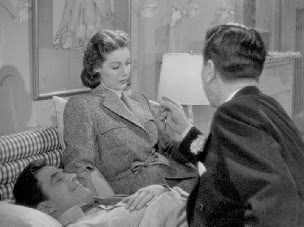Knights of the Round Table is a lavish MGM historical epic given the full treatment, shot in Cinemascope and Technicolor with all the trimmings. It’s exactly what you’d expect such a movie to be, for better or for worse.
We start with England in turmoil, in desperate need of a wise and strong king to unite the land. The first of the two claimants is Arthur Pendragon (Mel Ferrer), the illegitimate son of the previous king Uther Pendragon. The other is Modred (Stanley Baker), his claim being based on his marriage to Uther Pendragon’s only legitimate heir, his daughter Morgan le Fay (Anne Crawford). Arthur proves to be the successful claimant by virtue of being able to draw the sword Excalibur from the stone. Modred however has certainly not given up his ambitions.
While this is happening Lancelot of the Lake (Robert Taylor) has been seeking Arthur Pendragon, to offer him his allegiance and his sword. On his journey he meets two women, Elaine (Maureen Swanson) and Guinevere (Ava Gardner), two women destined to play important parts in his life and in the story.
Guinevere is to be married to Arthur so it is rather unfortunate that she and Lancelot fall in love. Both Guinevere and Lancelot are determined not to betray Arthur but clearly their love is going to cause more than a few problems.
The tone remains fairly light for the first half of the film with the emphasis on heroic deeds, battles, pageantry and the expenditure of large sums of money to make it all look impressive. Which it does. The tone will become progressively darker as both Lancelot and Guinevere are drawn into the webs being woven by Modred and Morgan le Fay.
The Arthurian legends are a large and diverse collection assembled over the course of many centuries. The story can be told as a tragedy, as a love story, as adventure, as spiritual quest or just about any other way a particular writer might choose. In this case the screenplay by Talbot Jennings, Jan Lustig and Noel Langley throws all of these elements into the mix, with uneven results.
The movie tries for a fairly realistic telling of the story, avoiding elements of the supernatural. Merlin (Felix Aylmer) is a wise counsellor to Arthur rather than a wizard and Morgan le Fay as a treacherous schemer rather than a witch. The quest for the Holy Grail is added as a minor subplot serving mostly to give an upbeat tone to what would otherwise be a tragic ending (which is hardly a spoiler since one assumes everyone knows Arthur’s destiny).
The movie tries to present the love between Guinevere and Lancelot as as being fundamentally chaste with both characters being determined not to betray Arthur. This has the unfortunate result of removing any real heat from the relationship and there is no real chemistry between Taylor and Gardner. The most unfortunate result is that Ava Gardner’s Guinevere becomes somewhat bland and sexless. Making Ava Gardner sexless was almost impossible but, alas, this movie succeeds in doing so. It also tends to make Lancelot a puppet in the hands of Modred and Morgan le Fay rather than a character with any real control over his fate.
Mel Ferrer is adequate as Arthur but the major problem with his performance is that Graham Chapman clearly based his performance as Arthur in Monty Python and the Holy Grail to a large extent on Ferrer’s, with the result that it’s sometimes difficult to take it as seriously as it was intended to be taken. Gabriel Woolf is excessively earnest as Sir Percival, which sadly undercuts any real spiritual feel to the Grail quest.
The big problem is that most of the cast find themselves impossibly constrained by the screenplay and unable to add any fire or zest to their performances. You know Ava Gardner wants the opportunity to be wicked but the script won’t let her. Robert Taylor at that time was becoming very good at playing flawed heroes, but he’s equally hampered by the script. I’m not arguing that the decision to have Lancelot and Guinevere putting duty before passion was a mistake in itself, but it needed to be shown to be a bit more of a genuine struggle.
The only actor not so constrained is Stanley Baker. He can play Modred as a full-blooded villain, which he proceeds to do with considerable relish and to very good effect. Baker’s Modred is the highlight of the movie, although Anne Crawford also makes Morgan le Fay colourfully vicious.
What we’re left with is mostly the spectacle, and luckily that aspect of the movie works pretty well despite some very obvious process shots. Director Richard Thorpe approaches the action scenes with confidence and the battles are quite well done, with the climactic clash between the armies of Arthur and Modred being nicely doom-laden and atmospheric.
The Warner Archive presentation is generally satisfactory with the anamorphic transfer capturing the glories of early 1950s Technicolour epics rather well.
Knights of the Round Table is a handsome production and the MGM gloss is almost enough to carry it through. It’s reasonable entertainment and Stanley Baker’s brooding Modred is a definite plus. Recommended with reservations if you’re a fan of 50s historical epics although it’s certainly not in the top rank of the genre.





























